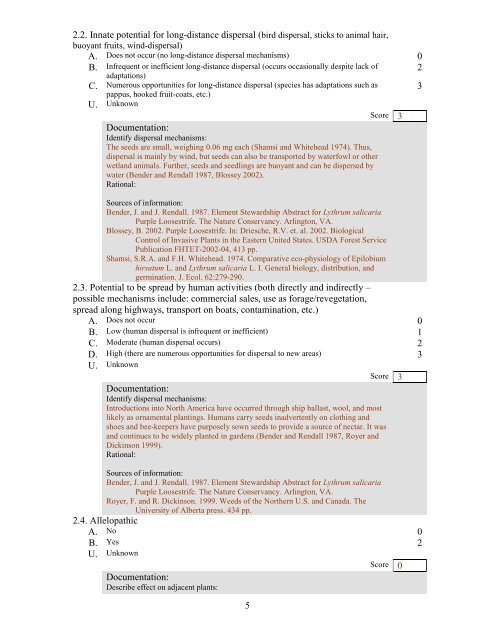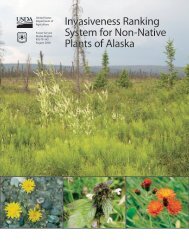AQIS Weed Risk Assessment - Alaska Natural Heritage Program
AQIS Weed Risk Assessment - Alaska Natural Heritage Program
AQIS Weed Risk Assessment - Alaska Natural Heritage Program
You also want an ePaper? Increase the reach of your titles
YUMPU automatically turns print PDFs into web optimized ePapers that Google loves.
2.2. Innate potential for long-distance dispersal (bird dispersal, sticks to animal hair,buoyant fruits, wind-dispersal)A. Does not occur (no long-distance dispersal mechanisms) 0B. Infrequent or inefficient long-distance dispersal (occurs occasionally despite lack of 2adaptations)C. Numerous opportunities for long-distance dispersal (species has adaptations such as 3pappus, hooked fruit-coats, etc.)U. UnknownDocumentation:Identify dispersal mechanisms:The seeds are small, weighing 0.06 mg each (Shamsi and Whitehead 1974). Thus,dispersal is mainly by wind, but seeds can also be transported by waterfowl or otherwetland animals. Further, seeds and seedlings are buoyant and can be dispersed bywater (Bender and Rendall 1987, Blossey 2002).Rational:5Score 3Sources of information:Bender, J. and J. Rendall. 1987. Element Stewardship Abstract for Lythrum salicariaPurple Loosestrife. The Nature Conservancy. Arlington, VA.Blossey, B. 2002. Purple Loosestrife. In: Driesche, R.V. et. al. 2002. BiologicalControl of Invasive Plants in the Eastern United States. USDA Forest ServicePublication FHTET-2002-04, 413 pp.Shamsi, S.R.A. and F.H. Whitehead. 1974. Comparative eco-physiology of Epilobiumhirsutum L. and Lythrum salicaria L. I. General biology, distribution, andgermination. J. Ecol. 62:279-290.2.3. Potential to be spread by human activities (both directly and indirectly –possible mechanisms include: commercial sales, use as forage/revegetation,spread along highways, transport on boats, contamination, etc.)A. Does not occur 0B. Low (human dispersal is infrequent or inefficient) 1C. Moderate (human dispersal occurs) 2D. High (there are numerous opportunities for dispersal to new areas) 3U. UnknownScore 3Documentation:Identify dispersal mechanisms:Introductions into North America have occurred through ship ballast, wool, and mostlikely as ornamental plantings. Humans carry seeds inadvertently on clothing andshoes and bee-keepers have purposely sown seeds to provide a source of nectar. It wasand continues to be widely planted in gardens (Bender and Rendall 1987, Royer andDickinson 1999).Rational:Sources of information:Bender, J. and J. Rendall. 1987. Element Stewardship Abstract for Lythrum salicariaPurple Loosestrife. The Nature Conservancy. Arlington, VA.Royer, F. and R. Dickinson. 1999. <strong>Weed</strong>s of the Northern U.S. and Canada. TheUniversity of Alberta press. 434 pp.2.4. AllelopathicA. No 0B. Yes 2U. UnknownScore 0Documentation:Describe effect on adjacent plants:
















